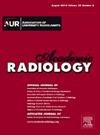Dual-energy CT Radiomics Combined with Quantitative Parameters for Differentiating Lung Adenocarcinoma From Squamous Cell Carcinoma: A Dual-center Study
IF 3.8
2区 医学
Q1 RADIOLOGY, NUCLEAR MEDICINE & MEDICAL IMAGING
引用次数: 0
Abstract
Rationale and Objectives
To evaluate the ability of dual-energy CT(DECT)-based quantitative parameters and radiomics features to differentiate solid lung adenocarcinoma (ADC) from squamous cell carcinoma (SCC).
Methods
This study included 213 patients diagnosed with ADC and SCC who underwent DECT scans at two centers from November 2022 to December 2023. Patients at center 1 were randomly divided into training (n = 114) and internal test set (n = 50) in a 7:3 ratio, with center 2 serving as the external test set (n = 49). Radiologic and clinical data were combined to establish a clinical-radiologic model. Ten types of DECT energy images including conventional images, iodine density (ID), effective atomic number (Zeff), electron density, and virtual mono-energetic images (VMI) were reconstructed in both arterial phases (AP) and venous phases (VP). Quantitative parameters were measured at the uniform enhanced solid portion of the tumor and normalized to the aorta, used to develop a quantification model and calculate the quantitative score (quantscore). Radiologists manually delineated the tumor ROI at the largest level for extracting radiomics features in these 10 energy images. These features were used to establish 10 uni-energy models from which the best-performing features were selected to construct the final radiomics model and calculate a radiomics score (radscore). Then, a combined model was developed using the akaike information criterion(AIC) and compared to the clinical-radiological model to test its diagnostic validity.
Results
The independent predictors of the clinical-radiological model included age, gender, and central or peripheral location, and the AUCs for the training set, internal test set, and external test set were 0.808, 0.837, and 0.802. The quantification model incorporated 40 keV CT values, Zeff, normalized Zeff, and the slope of the spectral attenuation curve (λHU) in the AP and normalized ID, Zeff, and λHU in the VP. Uni-energy models based on AP ID maps, AP Zeff maps, and VP VMI 65 keV significantly outperformed AUC = 0.5, and 11 radiomics features were selected from these three models to construct the final radiomics model. The combined model, incorporating age, gender, quantscore, and radscore, significantly outperformed the clinical-radiological model in the training set (AUC = 0.952 vs 0.808, P < 0.001), and demonstrated higher performance in both the internal and external test sets, although these differences did not reach statistical significance (AUC = 0.870 vs 0.837, for the internal test set [P = 0.542], 0.888 vs 0.802 for the external test sets [P = 0.128]). The evaluation of the combined model demonstrated good discriminative ability and potential for generalization.
Conclusion
The combined model, integrating quantitative parameters and radiomics features from DECT multi-energy images with clinical-radiological characteristics, can be used as a non-invasive tool to differentiate ADC from SCC.
双能 CT 辐射组学结合定量参数区分肺腺癌和鳞癌:一项双中心研究。
原理和目的:评估基于双能 CT(DECT)的定量参数和放射组学特征区分实性肺腺癌(ADC)和鳞状细胞癌(SCC)的能力:本研究纳入了213名确诊为ADC和SCC的患者,他们于2022年11月至2023年12月期间在两个中心接受了DECT扫描。中心1的患者按7:3的比例随机分为训练集(n = 114)和内部测试集(n = 50),中心2作为外部测试集(n = 49)。放射学和临床数据相结合,建立了临床放射学模型。在动脉期(AP)和静脉期(VP)重建了 10 种 DECT 能量图像,包括常规图像、碘密度(ID)、有效原子序数(Zeff)、电子密度和虚拟单能量图像(VMI)。定量参数在肿瘤均匀增强的实体部分测量,并与主动脉归一化,用于建立定量模型和计算定量分数(quantscore)。放射科医生在这 10 幅能量图像中提取放射组学特征时,手动划定最大级别的肿瘤 ROI。这些特征用于建立 10 个单能量模型,从中选出表现最好的特征来构建最终的放射组学模型并计算放射组学得分(radscore)。然后,利用阿凯克信息准则(AIC)建立一个组合模型,并与临床放射学模型进行比较,以检验其诊断有效性:临床放射学模型的独立预测因子包括年龄、性别、中心或外周位置,训练集、内部测试集和外部测试集的AUC分别为0.808、0.837和0.802。量化模型在AP中纳入了40 keV CT值、Zeff、归一化Zeff和频谱衰减曲线斜率(λHU),在VP中纳入了归一化ID、Zeff和λHU。基于 AP ID 图、AP Zeff 图和 VP VMI 65 keV 的单能量模型的 AUC= 0.5 明显优于 AUC=0.5,并从这三个模型中选出 11 个放射组学特征来构建最终的放射组学模型。在训练集中,整合了年龄、性别、quantscore 和 radscore 的组合模型明显优于临床-放射学模型(AUC=0.952 vs 0.808,P 结论:在训练集中,整合了年龄、性别、quantscore 和 radscore 的组合模型明显优于临床-放射学模型(AUC=0.952 vs 0.808,P 结论):将 DECT 多能图像中的定量参数和放射组学特征与临床放射学特征整合在一起的组合模型可用作区分 ADC 和 SCC 的无创工具。
本文章由计算机程序翻译,如有差异,请以英文原文为准。
求助全文
约1分钟内获得全文
求助全文
来源期刊

Academic Radiology
医学-核医学
CiteScore
7.60
自引率
10.40%
发文量
432
审稿时长
18 days
期刊介绍:
Academic Radiology publishes original reports of clinical and laboratory investigations in diagnostic imaging, the diagnostic use of radioactive isotopes, computed tomography, positron emission tomography, magnetic resonance imaging, ultrasound, digital subtraction angiography, image-guided interventions and related techniques. It also includes brief technical reports describing original observations, techniques, and instrumental developments; state-of-the-art reports on clinical issues, new technology and other topics of current medical importance; meta-analyses; scientific studies and opinions on radiologic education; and letters to the Editor.
 求助内容:
求助内容: 应助结果提醒方式:
应助结果提醒方式:


